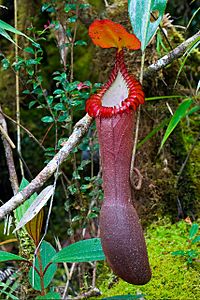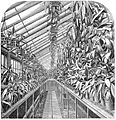Nepenthes facts for kids
Quick facts for kids Nepenthes |
|
|---|---|
 |
|
| Upper pitcher of Nepenthes edwardsiana | |
| Scientific classification | |
| Kingdom: | |
| Division: | |
| Class: | |
| Order: | |
| Family: |
Nepenthaceae
Dumort. (1829)
|
| Genus: |
Nepenthes
L. (1753)
|
| Species | |
|
See below or separate list. |
|
| Diversity | |
| ~120 species | |
 |
|
| Global distribution of Nepenthes. | |
| Synonyms | |
|
|
Nepenthes, also called Tropical Pitcher Plants or Monkey Cups, are amazing carnivorous plants. This means they eat insects! They belong to the plant family called Nepenthaceae. There are about 120 different kinds, or species, of Nepenthes. Scientists are always finding new ones! You can also find many mixed types, called hybrids, that grow naturally or are made by people.
Contents
Where Nepenthes Live
These cool plants grow in many places around the world. You can find them in South China, Indonesia, Malaysia, and the Philippines. They also grow west to Madagascar and the Seychelles. Southward, they reach Australia and New Caledonia. Northward, they are found in India and Sri Lanka.
Lowland vs. Highland Plants
Nepenthes plants are often grouped by where they live. Some are "lowland" varieties. These grow in hot, wet areas closer to sea level. They need lots of heat and humidity to thrive.
Other Nepenthes are "highland" varieties. These live high up in the mountains. They like warm days but need cold and humid nights. Knowing if a plant is lowland or highland helps people care for them properly.
How Nepenthes Look and Catch Prey

Nepenthes plants usually have a small root system. They have a stem that either lies on the ground or climbs. This stem can grow very long, sometimes over 15 meters (about 50 feet)!
Leaves and Pitchers
The stems have sword-shaped leaves that grow one after another. From the tip of each leaf, a long part called a tendril sticks out. This tendril helps the plant climb. At the end of the tendril, a special trap forms. This trap is called a pitcher. It starts as a tiny bud and slowly grows into a globe or tube shape.
The pitcher holds a liquid made by the plant itself. This liquid can be watery or thick. It helps to drown any prey that falls inside. The bottom part of the trap has special glands. These glands soak up nutrients from the insects the plant catches.
Pitcher Features
Just inside the top of the trap, there's a slippery, waxy layer. This makes it almost impossible for prey to climb out once they fall in. Around the opening of the trap is a colorful rim called the peristome. This "lip" is very slippery and attracts prey. But it offers a very unsteady place to land!
When it's wet, like after rain, the peristome gets even more slippery. A thin film of water forms, making insects slip and fall right into the pitcher. Above the peristome is a lid, called the operculum. For many Nepenthes species, this lid stops rain from filling up and diluting the liquid inside the pitcher. The underside of the lid often has nectar glands that also attract prey.
Two Types of Pitchers
Nepenthes plants usually make two different kinds of pitchers. This is called leaf dimorphism.
- Lower Pitchers: These are large traps that grow near the base of the plant. They usually sit on the ground.
- Upper Pitchers: These are often bigger and have different colors and features. They grow as the plant gets taller and matures. To help the plant stay steady, the tendril of an upper pitcher often forms a loop. This lets it wrap around nearby support.
What Nepenthes Eat
Most of the time, Nepenthes eat insects. But the biggest kinds of Nepenthes can sometimes catch small vertebrates. This includes tiny rats or lizards! There are even stories of these plants catching small birds when grown by people.
Reproduction and Life Cycle
Nepenthes plants have Flowers that grow in clusters. These clusters are called racemes or sometimes panicles. Each plant has either male or female flowers, but not both. This means you need two plants (a male and a female) for them to make seeds.
Pollination
Insects help these plants make seeds. This is called insect-pollination. Flies (like blow flies, midges, and mosquitoes), moths, wasps, and butterflies are the main helpers. The flowers can smell sweet, musty, or even like fungus.
Seeds
After pollination, seeds grow inside a four-sided seed pod. This pod can hold anywhere from 50 to 500 seeds! The seeds are light and have two wings, one on each side. This helps the wind carry them far away to new places.
Images for kids
-
Cultivated Nepenthes rajah, Nepenthes aristolochioides and other species
See also
 In Spanish: Plantas jarra para niños
In Spanish: Plantas jarra para niños










